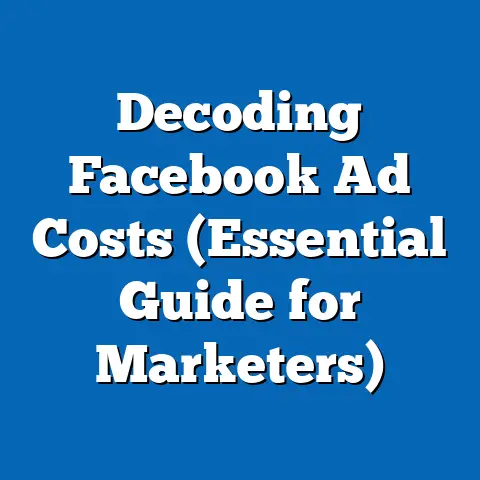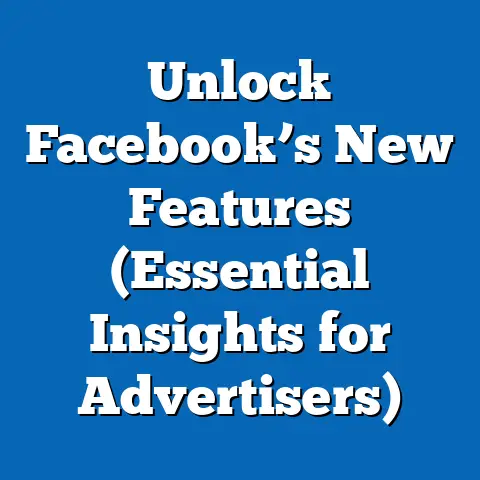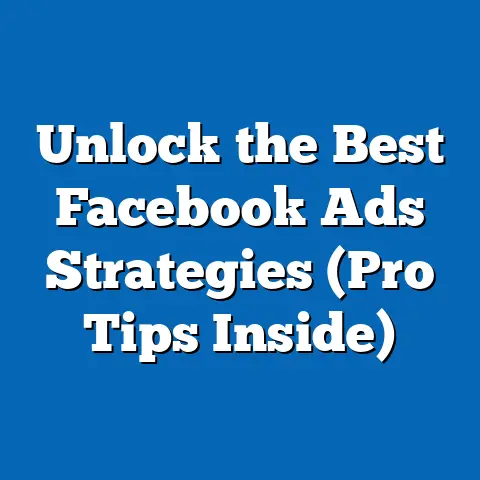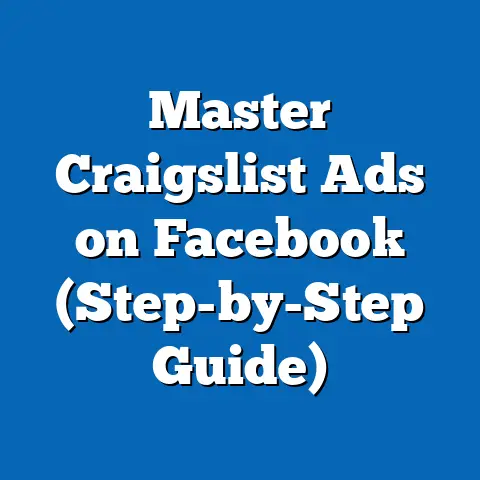Supercharge fb ad Strategy (Proven Targeting Techniques)
Imagine you’re about to renovate your living room. The excitement bubbles as you envision a space that reflects your style, functions perfectly for your needs, and becomes the heart of your home. You pore over design magazines, browse countless Pinterest boards, and carefully consider every detail from paint colors to furniture placement. You wouldn’t just randomly start tearing down walls, would you? No, you’d plan, budget, and target your efforts to achieve the best possible outcome.
Similarly, a Facebook ad strategy without precise targeting is like a home renovation without a blueprint. You might get lucky, but chances are you’ll waste time, money, and end up with a result that doesn’t quite meet your expectations. Just as homeowners need to carefully target their renovations to enhance their living space, businesses must strategically target their audiences to maximize the effectiveness of their Facebook ads.
In this guide, I’ll walk you through proven targeting techniques that will help you supercharge your Facebook ad strategy, turning your campaigns into powerful engines for growth. I’ve spent years honing these strategies, and I’m excited to share my insights with you. Let’s dive in!
Section 1: Understanding Your Audience
Before you even think about creating an ad, you need to understand who you’re trying to reach. This isn’t about making assumptions; it’s about digging deep and uncovering the real characteristics, interests, and behaviors of your ideal customer.
Think of it this way: You wouldn’t recommend a sleek, modern kitchen to someone who loves rustic farmhouse decor, right? Similarly, your ads need to resonate with the specific audience you’re targeting.
Here are some key concepts to consider:
- Demographics: These are the basic attributes of your audience, such as age, gender, location, education level, and job title.
- Interests: What are your audience members passionate about? What hobbies do they enjoy? What topics do they follow online?
- Behaviors: How do they interact with Facebook and the internet in general? What types of content do they engage with? What purchases do they make online?
One of the most valuable tools Facebook offers for audience research is Facebook Audience Insights. This free tool allows you to explore the demographics, interests, and behaviors of people connected to your Facebook page or a specific audience you define. I’ve used Audience Insights countless times to uncover hidden patterns and refine my targeting.
For example, I once worked with a local bakery that wanted to increase its online orders. Using Audience Insights, we discovered that their target audience wasn’t just “people who like baked goods,” but specifically “women aged 25-45 who are interested in baking, healthy recipes, and supporting local businesses.” This insight allowed us to create ads that resonated deeply with this specific demographic, resulting in a significant increase in online orders.
Creating Detailed Buyer Personas
Another crucial step is to create detailed buyer personas. A buyer persona is a semi-fictional representation of your ideal customer, based on research and data about your existing customers and target audience.
Think of it as building a character profile. Give your persona a name, age, occupation, and a backstory. What are their goals, challenges, and motivations? What are their pain points? What kind of language do they use?
By creating these detailed personas, you can better understand your audience’s needs and tailor your ads to address those needs effectively.
Example: The Eco-Conscious Consumer
Let’s say you’re selling sustainable clothing. Your buyer persona might be “Sarah,” a 32-year-old marketing professional who is passionate about environmental sustainability. She’s looking for stylish and ethically made clothing that aligns with her values. She’s willing to pay a premium for quality and transparency.
Knowing this, you can create ads that highlight the sustainable materials used in your clothing, the ethical production practices you follow, and the positive impact your brand has on the environment.
Key Takeaway: Understanding your audience is the foundation of a successful Facebook ad strategy. Use Facebook Audience Insights and create detailed buyer personas to gain a deeper understanding of your ideal customer.
Section 2: Leveraging Facebook’s Targeting Options
Once you have a solid understanding of your audience, it’s time to leverage Facebook’s powerful targeting options. Facebook offers three main types of targeting: Core Audiences, Custom Audiences, and Lookalike Audiences.
1. Core Audiences
Core Audiences allow you to target people based on demographics, interests, and behaviors. This is the most basic type of targeting, but it’s still incredibly powerful when used strategically.
- Demographic Targeting: Target people based on age, gender, location, education level, job title, relationship status, and more.
- Interest Targeting: Target people based on their interests, hobbies, and the pages they like on Facebook.
- Behavior Targeting: Target people based on their online behavior, such as their purchase history, the devices they use, and the ads they click on.
2. Custom Audiences
Custom Audiences allow you to target people who have already interacted with your business, either online or offline. This is a highly effective way to reach people who are already familiar with your brand.
- Customer List: Upload a list of your existing customers (email addresses, phone numbers) to target them on Facebook.
- Website Traffic: Use the Facebook Pixel to track website visitors and target them with ads on Facebook.
- App Activity: Target people who have used your mobile app.
- Engagement: Target people who have interacted with your Facebook page or ads, such as liking your page, watching your videos, or clicking on your ads.
3. Lookalike Audiences
Lookalike Audiences allow you to reach new people who are similar to your existing customers or website visitors. This is a great way to expand your reach and find new customers who are likely to be interested in your products or services.
- Source Audience: Choose a source audience, such as your customer list, website visitors, or Facebook page fans.
- Similarity: Select the desired level of similarity between the lookalike audience and the source audience. A smaller percentage will result in a more targeted audience, while a larger percentage will result in a broader audience.
- Location: Choose the location you want to target.
Segmenting Your Audiences
To maximize the effectiveness of your targeting, it’s important to segment your audiences based on specific criteria. This allows you to create ads that are highly relevant to each segment, increasing the likelihood of engagement and conversions.
For example, you could segment your audience based on:
- Location: Target different locations with different ads, highlighting local events or promotions.
- Age: Target different age groups with different messaging and visuals.
- Interests: Target people with specific interests with ads that are relevant to those interests.
- Purchase History: Target people who have previously purchased from you with ads for complementary products or services.
Example: Boosting Ad Performance with Targeted Ads
I once worked with an e-commerce store that sold fitness equipment. They were running generic ads that targeted “people interested in fitness,” but their results were underwhelming.
We decided to segment their audience based on specific interests, such as “yoga,” “weightlifting,” and “running.” We then created ads that were tailored to each of these segments, highlighting the specific benefits of their products for each activity.
For example, we created ads for yoga enthusiasts that featured yoga mats and blocks, while ads for weightlifters featured weight benches and dumbbells.
This targeted approach resulted in a significant increase in ad performance, with click-through rates and conversion rates doubling within a few weeks.
Key Takeaway: Facebook offers a wide range of targeting options. Leverage Core Audiences, Custom Audiences, and Lookalike Audiences to reach the right people with the right message. Segment your audiences based on specific criteria to maximize the effectiveness of your targeting.
Section 3: Utilizing Retargeting Strategies
Retargeting is a powerful technique that allows you to reach people who have already interacted with your brand, but haven’t yet converted into customers. It’s like leaving a trail of breadcrumbs for potential customers, reminding them of your products or services and encouraging them to take action.
Think of it this way: Someone visits your website, browses a few products, but doesn’t make a purchase. They’re clearly interested, but something is holding them back. Retargeting allows you to show them ads that remind them of the products they viewed, potentially nudging them towards a purchase.
The key to successful retargeting is the Facebook Pixel. This small piece of code that you install on your website tracks user behavior, allowing you to create custom audiences based on their actions.
Here’s how it works:
- Install the Facebook Pixel: Place the Facebook Pixel code on every page of your website.
- Track User Behavior: The Pixel tracks user actions, such as page views, product views, add-to-carts, and purchases.
- Create Custom Audiences: Use the data collected by the Pixel to create custom audiences based on specific user behaviors.
- Create Retargeting Ads: Show ads to these custom audiences, reminding them of your products or services and encouraging them to take action.
Setting Up a Retargeting Campaign: A Step-by-Step Guide
- Create a Custom Audience: In Facebook Ads Manager, create a custom audience based on website traffic. You can target people who have visited specific pages, viewed specific products, or added items to their cart.
- Create a Retargeting Ad Set: Create a new ad set and target the custom audience you just created.
- Create a Retargeting Ad: Design an ad that is relevant to the audience you’re targeting. For example, if you’re targeting people who added items to their cart but didn’t complete the purchase, you could show them an ad that offers a discount or free shipping.
Best Practices for Retargeting Ads:
- Use High-Quality Visuals: Your ads should be visually appealing and grab the attention of your audience.
- Personalize Your Messaging: Tailor your messaging to the specific audience you’re targeting.
- Offer Incentives: Consider offering a discount, free shipping, or other incentives to encourage people to take action.
- Use Urgency: Create a sense of urgency by highlighting limited-time offers or expiring promotions.
- Test Different Ad Creatives: Experiment with different ad formats, visuals, and messaging to see what works best.
Statistics and Success Stories:
Retargeting is a highly effective strategy that can significantly boost your ad performance. According to research, website visitors who are retargeted with display ads are 70% more likely to convert.
I’ve personally seen incredible results with retargeting campaigns. For example, I once worked with a furniture store that was struggling to convert website visitors into customers. We implemented a retargeting campaign that showed ads to people who had viewed specific furniture pieces on their website.
The results were astounding. Within a few weeks, their website conversion rate increased by 40%, and their overall sales increased by 25%.
Key Takeaway: Retargeting is a powerful technique for reaching people who have already interacted with your brand. Use the Facebook Pixel to track user behavior and create custom audiences. Design retargeting ads that are relevant, personalized, and offer incentives to encourage people to take action.
Section 4: Testing and Optimizing Your Targeting
Facebook advertising is not a “set it and forget it” activity. It requires continuous testing and optimization to ensure you’re getting the best possible results. This is especially true for your targeting strategies.
Think of it as fine-tuning your home renovation project. You might initially choose a specific paint color, but after seeing it on the walls, you realize it’s not quite right and decide to try a different shade. Similarly, you need to continuously test and refine your targeting strategies to optimize your ad performance.
A/B Testing for Targeting
A/B testing, also known as split testing, is a technique that allows you to compare two different versions of your ads or targeting strategies to see which one performs better.
Here’s how it works:
- Choose a Variable to Test: Select a specific variable to test, such as age range, interests, or ad placement.
- Create Two Versions: Create two versions of your ad set, each with a different value for the variable you’re testing.
- Run the Test: Run both ad sets simultaneously, ensuring that all other variables are kept constant.
- Analyze the Results: After a sufficient amount of time, analyze the results to see which ad set performed better.
Example: Testing Different Age Ranges
Let’s say you’re selling skincare products and you’re not sure which age range to target. You could create two ad sets:
- Ad Set A: Target people aged 25-34.
- Ad Set B: Target people aged 35-44.
Run both ad sets for a week and then analyze the results. If Ad Set A performs better, then you know that your skincare products are more appealing to people in the 25-34 age range.
Analyzing Ad Performance Metrics
To effectively optimize your targeting strategies, you need to track and analyze key ad performance metrics. Some of the most important metrics to consider include:
- Click-Through Rate (CTR): The percentage of people who see your ad and click on it.
- Conversion Rate: The percentage of people who click on your ad and complete a desired action, such as making a purchase or filling out a form.
- Cost Per Click (CPC): The average cost you pay for each click on your ad.
- Cost Per Acquisition (CPA): The average cost you pay for each conversion.
- Return on Ad Spend (ROAS): The amount of revenue you generate for every dollar you spend on advertising.
By tracking these metrics, you can identify areas for improvement and make data-driven decisions to refine your targeting strategies.
Common Pitfalls to Avoid During Testing:
- Testing Too Many Variables at Once: Focus on testing one variable at a time to ensure that you can accurately attribute the results to that specific variable.
- Not Running Tests Long Enough: Allow enough time for your tests to gather sufficient data before making any conclusions.
- Ignoring Statistical Significance: Make sure that the results of your tests are statistically significant before making any changes to your targeting strategies.
- Not Documenting Your Results: Keep a record of your test results so that you can track your progress and learn from your mistakes.
Key Takeaway: Continuous testing and optimization are essential for maximizing the effectiveness of your Facebook ad campaigns. Use A/B testing to compare different targeting strategies and track key ad performance metrics to identify areas for improvement. Avoid common pitfalls during the testing phase to ensure that you’re making data-driven decisions.
Section 5: Success Stories and Real-World Examples
Let’s take a look at a couple of brief success stories from companies that have successfully implemented advanced targeting techniques on Facebook.
Example 1: Subscription Box Company
A subscription box company that offers curated boxes for new parents used Facebook’s custom and lookalike audiences to target potential customers. They uploaded a list of their existing customers and created a lookalike audience based on that list. They also targeted people who had visited their website and added items to their cart but didn’t complete the purchase.
By combining these targeting strategies, they were able to significantly increase their conversion rate and acquire new customers at a lower cost.
Example 2: Local Restaurant
A local restaurant used Facebook’s location targeting and interest targeting to reach potential customers in their area. They targeted people who were interested in food, dining, and local restaurants. They also created ads that highlighted their daily specials and upcoming events.
This targeted approach helped them to attract new customers and increase their overall sales.
Key Takeaway: These success stories demonstrate the effectiveness of advanced targeting techniques on Facebook. By understanding your audience, leveraging Facebook’s targeting options, and continuously testing and optimizing your strategies, you can achieve significant results.
Conclusion
Just like a well-planned home renovation can transform your living space, a well-defined targeting strategy can transform your Facebook ad campaigns. By understanding your audience, leveraging Facebook’s targeting options, utilizing retargeting strategies, and continuously testing and optimizing your targeting, you can supercharge your ad performance and achieve your business goals.
Remember, success in Facebook advertising requires patience, creativity, and a willingness to adapt. So, embrace the journey, experiment with different strategies, and never stop learning. With the right approach, you can turn your Facebook ads into powerful engines for growth.
Now, it’s your turn. Take what you’ve learned in this guide and apply it to your own Facebook ad campaigns. Start by defining your target audience, leveraging Facebook’s targeting options, and setting up a retargeting campaign. Then, continuously test and optimize your strategies to maximize your results. Good luck!






